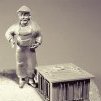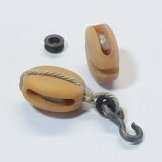-
Posts
5,195 -
Joined
-
Last visited
Reputation Activity
-
 michael mott got a reaction from Mirabell61 in HMS Pegasus 1776 by Mirabell61 - FINISHED - scale 1:64 - 16-gun sloop
michael mott got a reaction from Mirabell61 in HMS Pegasus 1776 by Mirabell61 - FINISHED - scale 1:64 - 16-gun sloop
Very clean copper work Nils.
Michael
-
 michael mott got a reaction from texxn5 in Charles W Morgan Whaleboat by Salty Sea Dog - Artesania Latina - Scale 1:25 - POF - first wooden boat build - SMALL
michael mott got a reaction from texxn5 in Charles W Morgan Whaleboat by Salty Sea Dog - Artesania Latina - Scale 1:25 - POF - first wooden boat build - SMALL
What a cheesy photograph!
Michael
-
 michael mott got a reaction from popeye the sailor in HMS Pegasus by realworkingsailor - Amati/Victory Models - 1/64
michael mott got a reaction from popeye the sailor in HMS Pegasus by realworkingsailor - Amati/Victory Models - 1/64
Andy it makes a lot of sense working in the stages that you are doing, those shrouds look great.
Michael
-
 michael mott got a reaction from realworkingsailor in HMS Pegasus by realworkingsailor - Amati/Victory Models - 1/64
michael mott got a reaction from realworkingsailor in HMS Pegasus by realworkingsailor - Amati/Victory Models - 1/64
Andy it makes a lot of sense working in the stages that you are doing, those shrouds look great.
Michael
-
 michael mott got a reaction from 4whelr in Charles W Morgan Whaleboat by Salty Sea Dog - Artesania Latina - Scale 1:25 - POF - first wooden boat build - SMALL
michael mott got a reaction from 4whelr in Charles W Morgan Whaleboat by Salty Sea Dog - Artesania Latina - Scale 1:25 - POF - first wooden boat build - SMALL
What a cheesy photograph!
Michael
-
 michael mott got a reaction from archjofo in Bristol Pilot Cutter by michael mott - 1/8 scale - POF
michael mott got a reaction from archjofo in Bristol Pilot Cutter by michael mott - 1/8 scale - POF
The .024" plastic coated Beadalon 49 strand wire works well. This is with the boom hanging loose and no extra tension, I need to get some smaller diameter black heat shrink. and make the loops bigger but I am happy with the way it is hanging. Also I need to reverse the inside chock. I think I will also make a small saddle for the wire to attach to the block rather than just the shackle.
Michael
-
 michael mott got a reaction from PeteB in Bristol Pilot Cutter by michael mott - 1/8 scale - POF
michael mott got a reaction from PeteB in Bristol Pilot Cutter by michael mott - 1/8 scale - POF
Akutansin, Elmir, thanks for your kind words.
I have been chipping away at the gaff, literally
using the shrink tubing i made a wire strop for the gaff
and was pleased with my stops set into the gaff they are boxwood
And now I know that the drawing in John Leathers book was correct and that the chock stops face the same direction
The wire is too stiff though so I need either thinner softer wire or I will use rope, I prefer the wire so will look at what options there are for that.
I did haul up the gaff using the blocks it was fun threading the halliards, I did a quick and dirty job of tying the halliards with hitches, I keep running out of shackles and blocks! and I take my hat off to all you folk building and rigging fully rigged three masters, that would send me to the loony bin.
It is interesting thinking about the different types of blocks needed for the rigging to function properly though.
The thing I need to address now is some cleats and belaying pins.
Earlier in the day I was working on the other boat.
Michael
-
 michael mott got a reaction from PeteB in Bristol Pilot Cutter by michael mott - 1/8 scale - POF
michael mott got a reaction from PeteB in Bristol Pilot Cutter by michael mott - 1/8 scale - POF
The .024" plastic coated Beadalon 49 strand wire works well. This is with the boom hanging loose and no extra tension, I need to get some smaller diameter black heat shrink. and make the loops bigger but I am happy with the way it is hanging. Also I need to reverse the inside chock. I think I will also make a small saddle for the wire to attach to the block rather than just the shackle.
Michael
-
 michael mott got a reaction from Calhoun Zabel in Bristol Pilot Cutter by michael mott - 1/8 scale - POF
michael mott got a reaction from Calhoun Zabel in Bristol Pilot Cutter by michael mott - 1/8 scale - POF
The .024" plastic coated Beadalon 49 strand wire works well. This is with the boom hanging loose and no extra tension, I need to get some smaller diameter black heat shrink. and make the loops bigger but I am happy with the way it is hanging. Also I need to reverse the inside chock. I think I will also make a small saddle for the wire to attach to the block rather than just the shackle.
Michael
-
 michael mott got a reaction from qwerty2008 in Bristol Pilot Cutter by michael mott - 1/8 scale - POF
michael mott got a reaction from qwerty2008 in Bristol Pilot Cutter by michael mott - 1/8 scale - POF
Akutansin, Elmir, thanks for your kind words.
I have been chipping away at the gaff, literally
using the shrink tubing i made a wire strop for the gaff
and was pleased with my stops set into the gaff they are boxwood
And now I know that the drawing in John Leathers book was correct and that the chock stops face the same direction
The wire is too stiff though so I need either thinner softer wire or I will use rope, I prefer the wire so will look at what options there are for that.
I did haul up the gaff using the blocks it was fun threading the halliards, I did a quick and dirty job of tying the halliards with hitches, I keep running out of shackles and blocks! and I take my hat off to all you folk building and rigging fully rigged three masters, that would send me to the loony bin.
It is interesting thinking about the different types of blocks needed for the rigging to function properly though.
The thing I need to address now is some cleats and belaying pins.
Earlier in the day I was working on the other boat.
Michael
-
 michael mott got a reaction from mtaylor in Bristol Pilot Cutter by michael mott - 1/8 scale - POF
michael mott got a reaction from mtaylor in Bristol Pilot Cutter by michael mott - 1/8 scale - POF
Akutansin, Elmir, thanks for your kind words.
I have been chipping away at the gaff, literally
using the shrink tubing i made a wire strop for the gaff
and was pleased with my stops set into the gaff they are boxwood
And now I know that the drawing in John Leathers book was correct and that the chock stops face the same direction
The wire is too stiff though so I need either thinner softer wire or I will use rope, I prefer the wire so will look at what options there are for that.
I did haul up the gaff using the blocks it was fun threading the halliards, I did a quick and dirty job of tying the halliards with hitches, I keep running out of shackles and blocks! and I take my hat off to all you folk building and rigging fully rigged three masters, that would send me to the loony bin.
It is interesting thinking about the different types of blocks needed for the rigging to function properly though.
The thing I need to address now is some cleats and belaying pins.
Earlier in the day I was working on the other boat.
Michael
-
 michael mott got a reaction from Wishmaster in Bristol Pilot Cutter by michael mott - 1/8 scale - POF
michael mott got a reaction from Wishmaster in Bristol Pilot Cutter by michael mott - 1/8 scale - POF
Akutansin, Elmir, thanks for your kind words.
I have been chipping away at the gaff, literally
using the shrink tubing i made a wire strop for the gaff
and was pleased with my stops set into the gaff they are boxwood
And now I know that the drawing in John Leathers book was correct and that the chock stops face the same direction
The wire is too stiff though so I need either thinner softer wire or I will use rope, I prefer the wire so will look at what options there are for that.
I did haul up the gaff using the blocks it was fun threading the halliards, I did a quick and dirty job of tying the halliards with hitches, I keep running out of shackles and blocks! and I take my hat off to all you folk building and rigging fully rigged three masters, that would send me to the loony bin.
It is interesting thinking about the different types of blocks needed for the rigging to function properly though.
The thing I need to address now is some cleats and belaying pins.
Earlier in the day I was working on the other boat.
Michael
-
 michael mott got a reaction from Script in I Received an Admiral's Allowance, How to Spend it?
michael mott got a reaction from Script in I Received an Admiral's Allowance, How to Spend it?
I also agree with Crackers, and Anthony, carry on with the model you are working on and when you get stuck because the tool you need is not in the family go and get it, be it a file or a jewelers saw a pair of fine needle-nosed pliers, whatever it might be.
It is a better way in my humble opinion, than just going spending.
Michael
-
 michael mott got a reaction from Senior ole salt in Bristol Pilot Cutter by michael mott - 1/8 scale - POF
michael mott got a reaction from Senior ole salt in Bristol Pilot Cutter by michael mott - 1/8 scale - POF
Matt missed you on the last post sorry about that.
Daniel, John, Russ, and Druxey, thanks for all you kind words, at the rate I'm going I sometimes wonder when it will get to the lake.
Today I managed to get enough time in to make a double block with a Becket. The sheaves are .375 diameter and the axle is .062, the brass is .125 x .031
I remembered a quote that one should treat every part as model in itself and this seems to work well for me.
Machined up a block of Degame (lemon-wood)
Did a lot of sanding and finishing with some fine steel wool. Made a pin for the Becket. the ring is .011 music wire.
Set it up on the mast with the other double block to see how it looks for the Gaff up-haul, I just used the weight from the ropewalk to give some body to the rope. I must finish those seizings on the shrouds.
The blocks work well together, this is a lot of fun, I need to get on and finish the gaff now, and of course there will be a few more blocks but the next few will be singles.
Michael
-
 michael mott got a reaction from PeteB in Bristol Pilot Cutter by michael mott - 1/8 scale - POF
michael mott got a reaction from PeteB in Bristol Pilot Cutter by michael mott - 1/8 scale - POF
Jmaitri, thanks for your kind remark.
late last night I set up the rope walk and had a go with the Hemp.
3 strands of 6lb
made some rope that is .071 inch diameter
3 strands of 48lb
made some rope that is .132 inches in diameter
That's all for now, off to help my friend again today.
Michael
-
 michael mott got a reaction from PeteB in Bristol Pilot Cutter by michael mott - 1/8 scale - POF
michael mott got a reaction from PeteB in Bristol Pilot Cutter by michael mott - 1/8 scale - POF
Greg thanks for stopping by and your kind words.
Today while out picking up some lumber for the other model I also stopped in a Michaels Store and purchased some Hemp beading cord. I am going to try the fine weight in the rope machine to see what sort of rope it makes.
This heavier stuff might work for making some rope fenders.
Michael
-
 michael mott got a reaction from billocrates in Bristol Pilot Cutter by michael mott - 1/8 scale - POF
michael mott got a reaction from billocrates in Bristol Pilot Cutter by michael mott - 1/8 scale - POF
Well that certainly was a bit of a shock.
I will not try to rebuild everything back to the begining but here is a brief overview of from there to here.
This pilot cutter is based on some plans that were published by MAP
(Model and Allied Press) back in the early 70's and those plans were actually
based on the fishing smack CK482. Those of you who have seen the build in the past
will already be familiar with what I have done so far.
The model is
LOD 63 inches
LOA 84 inches
Beam 18 inches
Draft 10 1/2 inches
My intention is to sail this model here are a few pics of the build
The frames are Jellutong, and the planking on the hull is Cedar.
The roller reefing is custom built around a worm gear on hand.
The mast is Clear Fir and the boom is Spruce.
The deck is double planked the lower planks are white pine glued and treenailed
into place the top planks are clear Fir the caulking is coloured Carpenters
glue the top planks will also be treenailed in place.
The cockpit surround is Honduras Mahogany as is the forward hatch and the cabin
sides.
The underside of the
cockpit coaming the walls will drop into the opening 2 1/14 inches and there
will be a gasket around the edge of the deck under the coaming. The cockpit
will be fixed into the hull with a couple of brass machine screws then a teak
floor grate will cover those. this way I can access the rudder controls and
keep the water
I have learned form this experience to back up everything and am now building my log in MSword and posting to the site.
It is great to have the site back.
Michael
-
 michael mott got a reaction from archjofo in Bristol Pilot Cutter by michael mott - 1/8 scale - POF
michael mott got a reaction from archjofo in Bristol Pilot Cutter by michael mott - 1/8 scale - POF
Mark thanks for your comment,
Bob I am thinking of only covering the inside curve that could chaff on the mast, so instead of stitching the leather like a glove I am thinking of glue with a row of tiny tacks along the top and bottom edges. more like this
Michael
-
 michael mott got a reaction from archjofo in Bristol Pilot Cutter by michael mott - 1/8 scale - POF
michael mott got a reaction from archjofo in Bristol Pilot Cutter by michael mott - 1/8 scale - POF
Jay thanks for stopping by and your kind words, yes the weather is being a little inclement at the moment more than the rain on Maria it is rather cool at the moment it was only 16 degrees Celsius yesterday, and is going down to 8 degrees Celsius tonight.
After spending a good chunk of yesterday afternoon cleaning and tidying up the shop, I did a little work on the gaff. I made the metal hanger for attaching the Halliard and down-haul it is 1/16th by 1/4 inch brass, also ground a tool for making some beads out of a short dowel of Lignum Vitea The dowel was turned on the lathe from some square stock. that I cut off the billet I have had for perhaps 20 years at least.
The rope holding the parrel beads is made from Gutterman black cotton.
The beads are a scale 1 1/2" in diameter. I still have to make the slide block it will fit in the 3/16 slot. once I have made the slide I will go back and finish the leather for the jaws.
Michael
-
 michael mott got a reaction from PeteB in Bristol Pilot Cutter by michael mott - 1/8 scale - POF
michael mott got a reaction from PeteB in Bristol Pilot Cutter by michael mott - 1/8 scale - POF
Mark thanks for your comment,
Bob I am thinking of only covering the inside curve that could chaff on the mast, so instead of stitching the leather like a glove I am thinking of glue with a row of tiny tacks along the top and bottom edges. more like this
Michael
-
 michael mott got a reaction from aykutansin in Bristol Pilot Cutter by michael mott - 1/8 scale - POF
michael mott got a reaction from aykutansin in Bristol Pilot Cutter by michael mott - 1/8 scale - POF
Mark thanks for your comment,
Bob I am thinking of only covering the inside curve that could chaff on the mast, so instead of stitching the leather like a glove I am thinking of glue with a row of tiny tacks along the top and bottom edges. more like this
Michael
-
 michael mott got a reaction from kees de mol in Bristol Pilot Cutter by michael mott - 1/8 scale - POF
michael mott got a reaction from kees de mol in Bristol Pilot Cutter by michael mott - 1/8 scale - POF
Jay thanks for stopping by and your kind words, yes the weather is being a little inclement at the moment more than the rain on Maria it is rather cool at the moment it was only 16 degrees Celsius yesterday, and is going down to 8 degrees Celsius tonight.
After spending a good chunk of yesterday afternoon cleaning and tidying up the shop, I did a little work on the gaff. I made the metal hanger for attaching the Halliard and down-haul it is 1/16th by 1/4 inch brass, also ground a tool for making some beads out of a short dowel of Lignum Vitea The dowel was turned on the lathe from some square stock. that I cut off the billet I have had for perhaps 20 years at least.
The rope holding the parrel beads is made from Gutterman black cotton.
The beads are a scale 1 1/2" in diameter. I still have to make the slide block it will fit in the 3/16 slot. once I have made the slide I will go back and finish the leather for the jaws.
Michael
-
 michael mott got a reaction from Chuck in 18th-century Pinnace by Chuck - FINISHED - 1/2" scale
michael mott got a reaction from Chuck in 18th-century Pinnace by Chuck - FINISHED - 1/2" scale
Beautiful model Chuck, I could see myself making one at 1 1/2 inch scale, after I get a couple of other projects finished.
Michael
-
 michael mott got a reaction from mtaylor in Licorne by mtaylor - 3/16" scale - POF - TERMINATED LOG
michael mott got a reaction from mtaylor in Licorne by mtaylor - 3/16" scale - POF - TERMINATED LOG
Mark the planking looks nice and tight.
Michael
-
 michael mott got a reaction from Wishmaster in Bracera by Wishmaster - FINISHED - scale 1:20
michael mott got a reaction from Wishmaster in Bracera by Wishmaster - FINISHED - scale 1:20
Elmir the work you have done so far looks terrific.
Michael
















